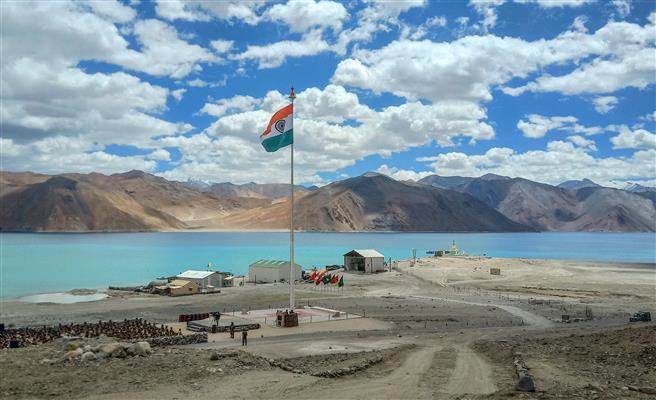Recent Indo-China border face-offs at Galwan Valley led to loss of 20 army personnel. Previously India-China border witnessed tensions during April-May 2020 with incidents reported from at least four locations including Pangong Lake(Ladakh), Naku La(Sikkim), Galwan Valley( Ladakh) and Demchok(Ladakh). According to various experts it is an critical issue and growing threat to global cooperation. Exploration of Comprehensive Boundary Agreement along with all stakeholders, may serve as possible solution.
New Delhi standoff with Beijing in Galwan Valley, where not many incidents were reported earlier, was result of construction activities initiated by it. The standoff was triggered by China’s moving troops to stop construction activities. India firmly believes that construction was well behind Line of Actual Control(LAC) countering China, which think it as illegal construction on its side. The unexpected tension was result of India’s aim to improve infrastructure in all North-Eastern states. Unlike Galwan Valley, Pangong Lake always served as point of dissent between the two nations because boundary perceptions here vary to a great extent.
Line of Actual Control or LAC is an international boundary between India and China. The line is popularly called as McMahon Line, after Sir Henry McMahon, who deliberately made it. In 1913, the British-Indian government organised a tripartite conference. In the conference the boundary between India and Tibet was formalized after detailed discussions on both sides. Later on a convention was adopted which resulted in the delimitation of the Indo-Tibetan boundary. But the boundary is never acknowledged by China. In 1957, China occupied Aksai Chin—region that is administered by China as part of Xinjiang Province and Tibet Autonomous region and claimed by India as a part of Union Territory of Ladakh. The annexation of Aksai Chin culminated into series of intermittent clashes along the border. Which later resulted in Indo-China war of 1962.
Since then LAC has never been demarcated. As a result there is always dispute between the two nations, which ultimately results in clashes. Another reason is the improper implementation of protocols which were agreed in 2005 and 2013. There are 23 disputed areas along non-demarcated, 3488 km long LAC including Kaurik, Ship kila in Himachal Pradesh; Barahoti, Pulan Sunda in Uttrakhand; Demchok, Trig Heights, Dumchele, Pangong Tso, Chumar and Spanggur Gap in Ladakh; Namkha chu, Sumdorong chu, Asaphila, Longju, Dichu, Yangtse, Fish tail 1 and 2 in Dibang Valley of Arunachal Pradesh. Main differences are in western and Eastern regions.India believes China is occupying 38000 sq Km in Aksai Chin region and in east China claims that India is occupying 90000 sq Km extending through Arunachal Pradesh. Tawang in Indian state of Arunachal Pradesh is claimed by China in recent years, which was always refused by India. As per consequences of disputed boundary, on an average India witnesses around 300 transgressions by People Liberation Army (PLA)—armed forces of the People’s Republic of China, founding and ruling party of China. The number saw sudden increase in 2017 where the figure increased to 426.
The recent confrontations indicates failure of diplomacy where Indo-China relations are deteriorating. It is exacerbated by the fact that Indians had turned their mood against China and Chinese commodities. Similar atmosphere was developed between India and China during 1950s. In March 1959,when China annexed Aksai Chin region and granted Asylum to Tibetan monk Dalai Lama, which later enhanced complication between both. Later in in October 1959 due to face-off between India and China at Kong Ka La (Ladakh), 9 soldiers were killed and 3 were detained. The long quest of independent boundary ultimately led to 1962 war. It caused major loss to India and its armed forces. The war inflicted several wounds on national soul. Indo-China relations experienced a major thrust when Prime Minister Rajiv Gandhi visited China in December 1988. The relations are now at a quiet good place, hence possibility of second war like 1962 is nearly impossible
Several attempts were maid to resolve the issue. In 1988, when former Prime Minister Rajiv Gandhi visited to China, a Joint Working Group (JWG) was set up to look into border problem. In 1993, the Agreement on Maintenance and Tranquillity along LAC was signed and the India-China Expert Group of Diplomatic and Military Officers was set up to assist the earlier JWG. In 1996, the Agreement on Confidence Building Measures (CBM)s in military filed was signed to deliberate on LAC. Later in 2003 two special representative held approx 17 rounds of talks. But no appropriate solution was introduced.
In 2005 an agreement was signed on political parameters and guiding principles. The following agreement completed the first three stages. The 2005 agreement said that “ both sides shall safeguard due interest of there settled population in border areas”. Similarly many protocols were agreed in 2013 regarding prevention of such clashes. The point of concern is protocols and agreements were never followed properly. On the other hand India’s effort to resolve the ongoing dispute cannot be neglected. India had proposed and exercise to clarify different perceptions of LAC. The exercise resulted in sharing of maps in the middle region but on account of western and Eastern regions the exercise failed. China rejected the exercise believing it would certainly add more complications.
The developments along LAC can be seen against the informal summits. The Wuhan Summit (2018) and Mamallapuram Summit (2019) between Indian Prime Minister Narendra Modi and Chinese President Xi jinping, which called for peaceful and diplomatic resolution of any conflict can lose its pace due to these confrontations. However, it should be primary interest of both side to avoid any military confrontation and seek peaceful co-existence.China who already enjoys an advantage in both terrain and infrastructure should understand the Indian context of developing wide range of infrastructure in northeast.
Due to rising clashes bilateral relations another criterias like economy, cyber field, 5G, national security, telecommunication, and manufacturing are under considerable strain. It was thought that corps Commander Level talk on 6 June will de-escalate the tensions between the two but no visible recovery was seen. Indian needs to think patiently as India is dealing with other multiple problems like covid-19 crisis, extended lockdown, displaced migrants, stagnant demand, slow growth of economy and boundary dispute with Nepal. India and China are amongst the largest economy, demography, markets and militaries of the world.It is in the interest of both the countries to formalize a boundary agreement.
A comprehensive strategy must be developed with effective strategic communication from both sides. It would be most righteous step in the direction of India as a global leader. India should give more thrust to its Act East and Neighbourhood First policy. India should take initiatives to insist on timely and early classification of LAC. Both countries can effectively use their soft powers like tourism, entertainment, food, education to further integrate their economies. In this context tourism through education especially on Buddhist account must be promoted. Temporary solution should be focusing on demilitarisation from both sides. Both side can reach towards an joint agreement to stop in-future confrontations. For long term solution an International Boundary Dispute Organisation(IBDO) can be formed by involving all stakeholders from both sides. The IBDO should meet as early as possible or can meet virtually in the wake of COVID-19 lockdowns to establish Comprehensive Boundary Agreement.
The present situation provides an opportunity to India to retrofit it’s foreign policy. India has been in continuous engagement with China through bilateral(informal summits) and multi lateral forums like BRICS, SCO and Russia-India-China trilateral meet. Such cooperation is aimed at maintaining overall stability. This cooperation needs to be increased. Cooperation from other countries should also be considered like US, Japan Australia and Quad initiative to counter China growing power in every political sphere.
India has adopted a policy of external balancing to tackle China’s hegemony. External balancing is forging of military cooperation with one or more state to defeat any threat to the following country. But India should also focus on internal balancing i.e. increasing cooperation with its states to increase human resource, arms and ammunition to counter China. It is imperative to solve the boundary dispute as both nations aims to become symbol of global cooperation. The likelihood of a Comprehensive Boundary Agreement appears remote but nothing can be termed as impossible unless it is tried. As Boundary Agreement would need certain time to be formalized, the most realistic solution in the present scenario would be minor adjustments along LAC to stop further confrontations.










